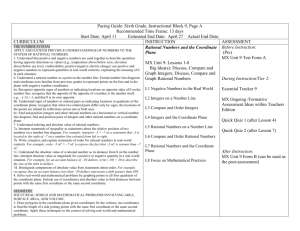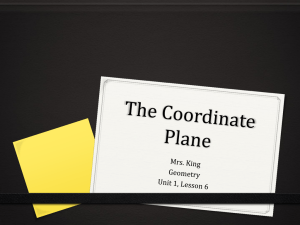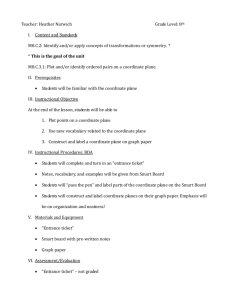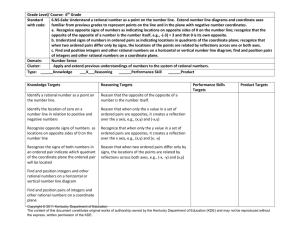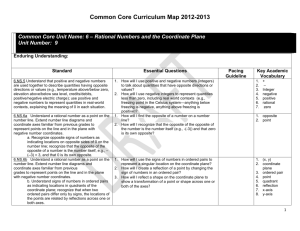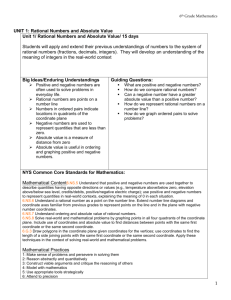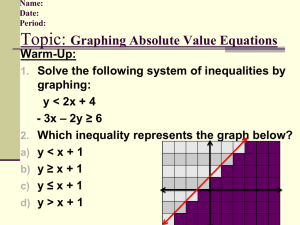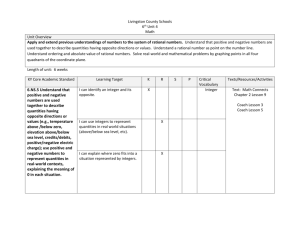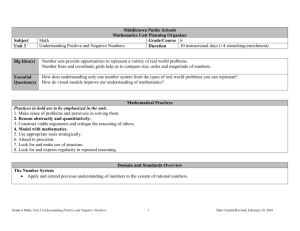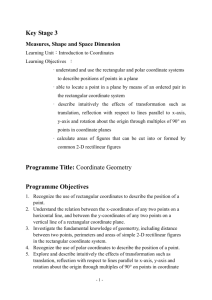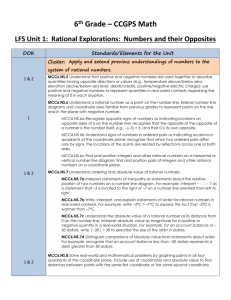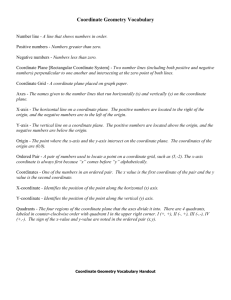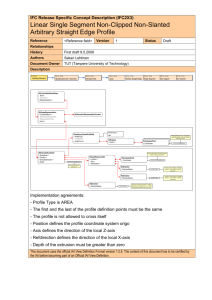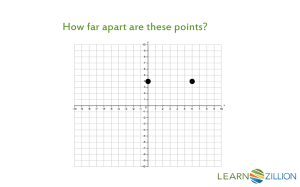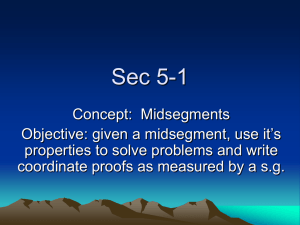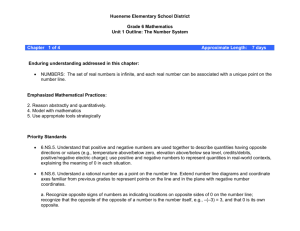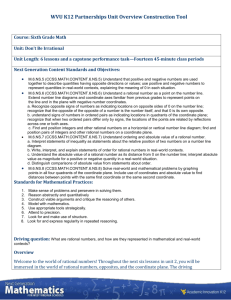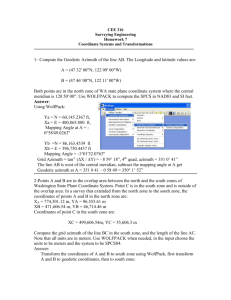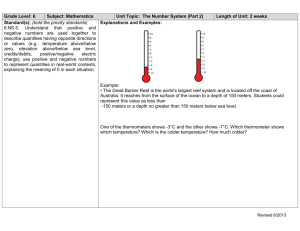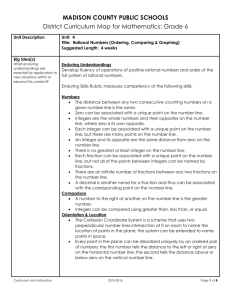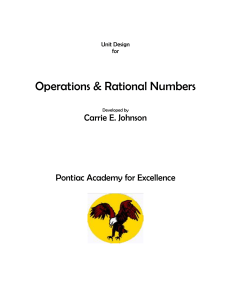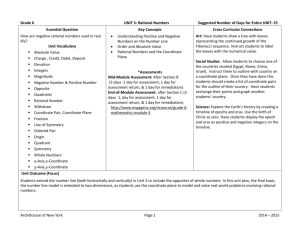NJDOE MODEL CURRICULUM PROJECT CONTENT AREA
advertisement
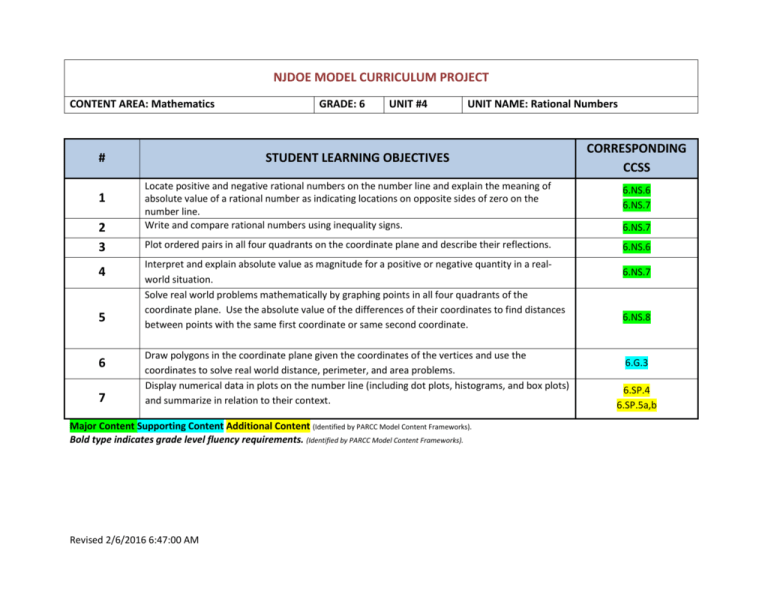
NJDOE MODEL CURRICULUM PROJECT CONTENT AREA: Mathematics # 1 2 3 4 5 6 7 GRADE: 6 UNIT #4 UNIT NAME: Rational Numbers STUDENT LEARNING OBJECTIVES CORRESPONDING CCSS Locate positive and negative rational numbers on the number line and explain the meaning of absolute value of a rational number as indicating locations on opposite sides of zero on the number line. Write and compare rational numbers using inequality signs. 6.NS.6 6.NS.7 Plot ordered pairs in all four quadrants on the coordinate plane and describe their reflections. 6.NS.6 Interpret and explain absolute value as magnitude for a positive or negative quantity in a realworld situation. Solve real world problems mathematically by graphing points in all four quadrants of the coordinate plane. Use the absolute value of the differences of their coordinates to find distances between points with the same first coordinate or same second coordinate. Draw polygons in the coordinate plane given the coordinates of the vertices and use the coordinates to solve real world distance, perimeter, and area problems. Display numerical data in plots on the number line (including dot plots, histograms, and box plots) and summarize in relation to their context. Major Content Supporting Content Additional Content (Identified by PARCC Model Content Frameworks). Bold type indicates grade level fluency requirements. (Identified by PARCC Model Content Frameworks). Revised 2/6/2016 6:47:00 AM 6.NS.7 6.NS.7 6.NS.8 6.G.3 6.SP.4 6.SP.5a,b NJDOE MODEL CURRICULUM PROJECT CONTENT AREA: Mathematics GRADE: 6 UNIT #4 UNIT NAME: Rational Numbers Selected Opportunities for Connection to Mathematical Practices 1. Make sense of problems and persevere in solving them. 2. Reason abstractly and quantitatively. SLO #2 Use inequality symbols to make comparisons. 3. Construct viable arguments and critique the reasoning of others. 4. Model with mathematics. SLO #6 Represent polygons on a coordinate plane. 5. Use appropriate tools strategically. SLO #7 Use spreadsheets when working with data sets with a large quantity of data points. 6. Attend to precision. 7. Look for and make use of structure. 8. Look for and express regularity in repeated reasoning. All of the content presented at this grade level has connections to the standards for mathematical practices. Bold type identifies possible starting points for connections to the SLOs in this unit. Code # 6.NS.6 6.NS.7 Common Core State Standards Understand a rational number as a point on the number line. Extend number line diagrams and coordinate axes familiar from previous grades to represent points on the line and in the plane with negative number coordinates. a. Recognize opposite signs of numbers as indicating locations on opposite sides of 0 on the number line; recognize that the opposite of the opposite of a number is the number itself, e.g., –(–3) = 3, and that 0 is its own opposite. b. Understand signs of numbers in ordered pairs as indicating locations in quadrants of the coordinate plane; recognize that when two ordered pairs differ only by signs, the locations of the points are related by reflections across one or both axes. c. Find and position integers and other rational numbers on a horizontal or vertical number line diagram; find and position pairs of integers and other rational numbers on a coordinate plane. Understand ordering and absolute value of rational numbers. a. Interpret statements of inequality as statements about the relative position of two numbers on a number line Revised 2/6/2016 6:47:00 AM NJDOE MODEL CURRICULUM PROJECT CONTENT AREA: Mathematics GRADE: 6 UNIT #4 UNIT NAME: Rational Numbers diagram. For example, interpret –3 > –7 as a statement that –3 is located to the right of –7 on a number line oriented from left to right. b. Write, interpret, and explain statements of order for rational numbers in real-world contexts. For example, write – 3 oC > –7 oC to express the fact that –3 oC is warmer than –7 oC. c. Understand the absolute value of a rational number as its distance from 0 on the number line; interpret absolute value as magnitude for a positive or negative quantity in a real-world situation. For example, for an account balance of –30 dollars, write |–30| = 30 to describe the size of the debt in dollars. d. Distinguish comparisons of absolute value from statements about order. For example, recognize that an account balance less than –30 dollars represents a debt greater than 30 dollars. Solve real-world and mathematical problems by graphing points in all four quadrants of the coordinate plane. Include the use 6.NS.8 of coordinates and absolute value to find distances between points with the same first coordinate or the same second coordinate. Draw polygons in the coordinate plane given coordinates for the vertices; use coordinates to find the length of a side joining 6.G.3 points with the same first coordinate or the same second coordinate. Apply these techniques in the context of solving realworld and mathematical problems. 6.SP.4 Display numerical data in plots on a number line, including dot plots, histograms, and box plots. Summarize numerical data sets in relation to their context, such as by: a. Reporting the number of observations. 6.SP.5 b. Describing the nature of the attribute under investigation, including how it was measured and its units of measurement. Major Content Supporting Content Additional Content (Identified by PARCC Model Content Frameworks). Bold type indicates grade level fluency requirements. (Identified by PARCC Model Content Frameworks). Revised 2/6/2016 6:47:00 AM
